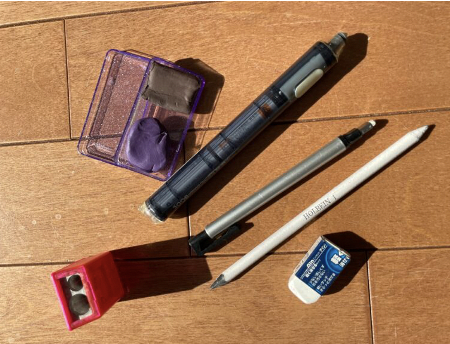On to erasers…

There are lots of erasers out there. A plain eraser works just fine. There is also the Tombow Mono eraser (the thin silver one below). I like the Ultra Fine 2.3mm because you can get some very tiny lines - good for whiskers on cats and things like that. I'd also pick up a kneadable eraser. Quality varies but one from the ¥100 shop works okay and smells good!
The larger eraser that works on batteries is similar to the Tombow. A fun and useful eraser once you make more progress.
Of course, a pencil sharpener comes in handy. Finally, the little white paper thingy is called a blender or paper stump. They come in a variety of sizes. You use them to spread graphite to make shadows or to darken the pencil marks you've made.

Adding color to a page is easy if you have watercolors, watercolor pencils or crayons. Don't worry so much about quality to begin with.
(NOTE: If you use watercolor on very thin journal paper, it will probably seep through. Be careful with using water-based erasable pens like Frixion because the writing will disappear in water or with heat - be extra careful if you use a hairdryer to dry the page because writing nearby will disappear!)
Later on, you can play with acrylic paints. You can find these at the ¥100 store, too.
But don't think you need paints or even markers to add color to a page. Try using labels from cat food cans, canned tomatoes, or advertising from the newspaper or magazine. Tear or cut them up into little pieces and glue them to the page. You can create LOTS of beautiful effects just using the things you find around you. Leaves are a cool source that also add texture. Buttons? String/yarn, old jewelry, candle wax, the sky's the limit!

Pentel makes these little watercolor brushes. You fill them with water, and then you can carry them with you. Great for doing some little projects while you're on the train or waiting at the bank.
And that's about all...
You'll need to get started. The important thing is to just start. Don't worry so much about the tools. You'll learn as you go along. With that in mind, however, if you are aiming at practicing in order to create fine, lasting works of art, the tools you use (quality of paper, watercolors, pencils - for sure) are extremely important. You don't want to be disappointed in the quality of what you're creating because you've used low-quality materials and tools.
BUT if you're having fun, learning to relax and enjoy doing art, start with what you have, and...
HAVE FUN!
Leave a comment on my Facebook page! ruizuart